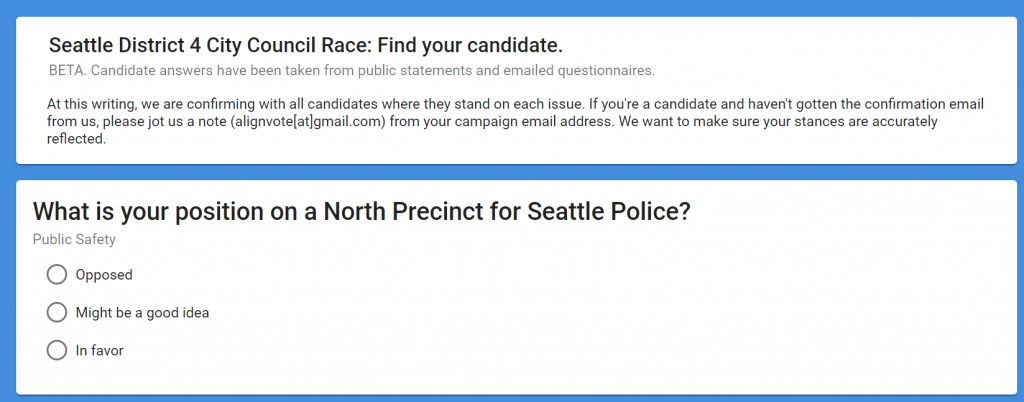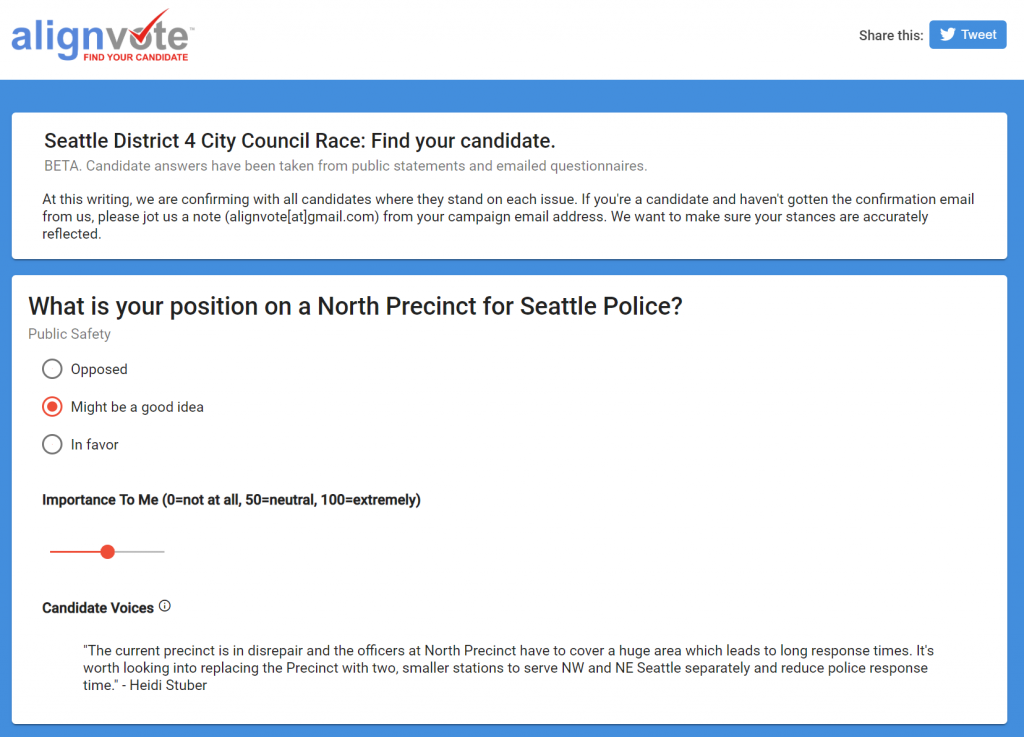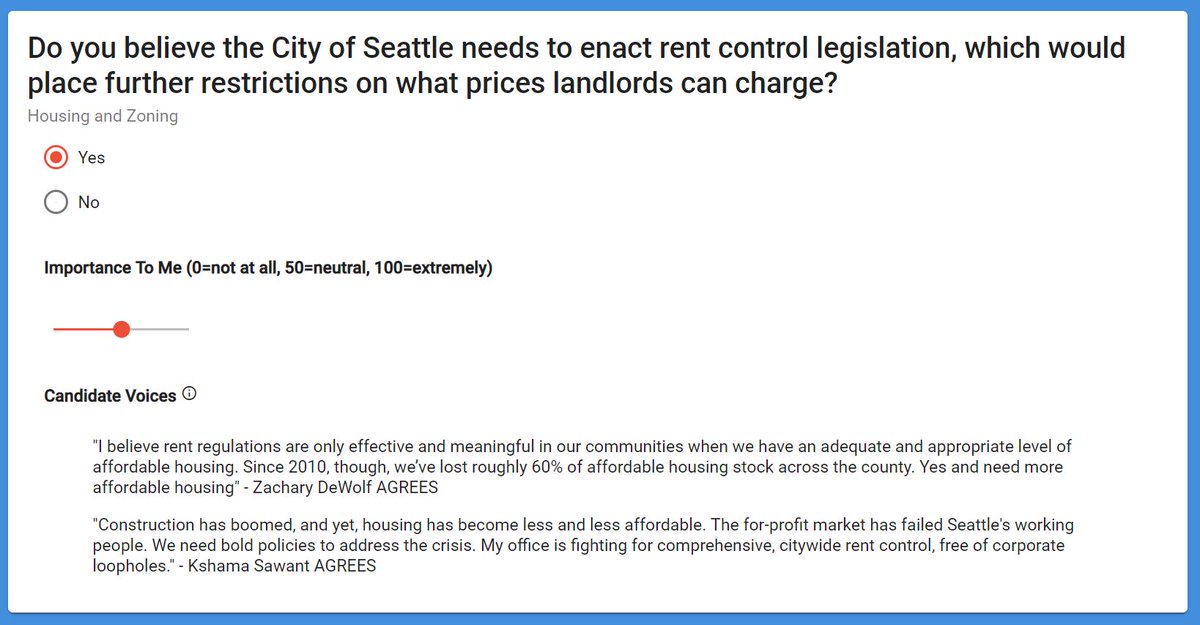New ALIGNVOTE Feature: Candidate Voices
Immediately upon launch of the candidate-facing preview of ALIGNVOTE last Wednesday, I heard a great feature request from D4 candidate Heidi Stuber. Paraphrasing our exchange:
“I understand why multiple choice is great for finding a match, but often, multiple choice questions have a need for explanation as to why a particular stance was selected. Please allow me to elaborate on an answer.”
A few days later, I heard that request from two other candidates.
I told her by email then that I thought that her suggestion was a terrific and important feature, and that I’d implement it as quickly as I could, but that for various reasons I wanted to get the beta up and going. But no question, she’s right: some multiple choice answers can lose a great deal of nuance, and it’s important to offer candidates a chance to elaborate upon why they selected the option they did. Today, the day after the voter-facing public beta was announced, I’m pleased to report that this feature has been implemented on both the candidate-facing view and the voter-facing view. Candidates, now it’s your turn.
I’ve lamented before in a different context that nuance is in hibernation in America, and I definitely don’t like that trend. It’s happening on both the far right and the far left. Complex issues rarely have simple explainers or options. And I’m happy to do what I can to make room for nuance in a very tiny but important way.
One dilemma I thought about was how and when to present it to the voter. I also wanted to do it in such a way that it didn’t “push” the voter too much before they have had a chance to think and take their own stand. Sometimes, allowing a shift in our preconceived notion is an important part of politics and moving forward, and personally, I think it’s good to encourage pauses for reflection, and make space for moments where it can happen.
It’s important to note that by itself, the text of what’s written is not going to improve a match score, because ALIGNVOTE cannot read the voter’s mind and know whether that’s what they think too. It only sees which ultimate option is chosen and whether it matches the stance the candidate has, and applies the relative weighting of that issue to figure out how “closely aligned” on the questions provided they are. But reading this explanatory text on a position might be very informative to you about which option you should choose, and give you, the voter, a chance to compare brief and to-the-point rationales.
So here’s the way it works:
First, the Candidate Gets an Easy Way to Optionally, Briefly Elaborate
ALIGNVOTE sent all campaigns an email earlier today a link that lets them elaborate on any or all answers. Every single campaign got emailed this link, based upon the officially registered email address on file with the City of Seattle. They need to double-check SPAM folders or re-request it from us. (I cannot just send it to any old email address, for what I hope are understandable reasons.)
ALIGNVOTE indicates clearly that elaborating is optional, and the text of what’s written will not change the match-scoring, but it might encourage a voter to align with their stance on the issue, thus encouraging a greater match score and resultant ranking.
Elaborations are only allowed to those candidates who confirm their stances via the ALIGNVOTE surveys sent.
Personal note: Candidates, take a stand and choose an option; that’s a big part of what we’re electing you to do. One of the things ALIGNVOTE fights against is attempting to have one’s cake and eating it too. Candidates can update their elaboration at any time via their link, but stances are locked in unless they email us.
In the ALIGNVOTE Interview, the Voter Sees the Question and Ponders their Stance…

Let’s say they first choose “Might be a good idea.”
Candidate Voices are Revealed, if Present
There’s a “Candidate Voices” section that’s revealed, with a shuffled list of responses from candidates. ALL available candidate voices on the issue (not just the selected stance) are provided. There is no selection or filtering. If a candidate submits a sentence or two via their ALIGNVOTE survey, it is displayed. ALL candidate views are displayed; these are in no way filtered or curated or altered or hidden by ALIGNVOTE. You, the voter, see what the candidate wrote:

- You, the voter are free to revise your choice or weighting based on the candidate’s official voice on the issue.
- ALIGNVOTE shuffles the display order of candidate voices when one or more is present, so that one candidate doesn’t always get top billing or the last word. (At this writing, this is the first use of randomization in ALIGNVOTE. Known bug: Currently doesn’t shuffle until there are three or more elaborations in the list for a given issue. Addressing soon.)
- If no candidate in the race offers an elaboration, no “Candidate Voices” subsection is displayed.
- The elaborations are a maximum of 240 characters each, the current maximum length of a Tweet.
- The elaborations can be updated at any time by the candidate if they so choose. This policy may change based upon logistical ease, but for now, that’s the case — it can be changed as issues or news warrant.
- Only those candidates who have actually completed and submitted the ALIGNVOTE stance survey (officially confirming their stances) will have their statements displayed to voters.
For Candidates, It’s a Great Way to Get Your Message to Voters
High-propensity voters will be using this tool. Candidates shouldn’t miss the opportunity to get their stances and messages to voters who are pondering their own views on an issue. We strongly encourage all candidates to complete their ALIGNVOTE survey, and suggest that they use the new elaborations feature to reach voters with a succinct description of their rationale for their stances.
Please give busy candidates and campaigns the benefit of the doubt by noting that this is a brand new feature, only hours old. Only hours ago did all candidates receive the ability to actually enter their stances, so it understandably may take time for them to craft the right 240 character stances. That’s reasonable.
To see the feature in action, visit the D4 Race, as the candidate who suggested this feature has already provided her comments.
Other Updates Released Today
We are still in beta and will be for a while.
- Explanatory text on the weighting slider
- Privacy Policy
Answers to a few questions
No changes to the match scoring algorithm have been made since we went live. None. Zero. If you’re seeing better rankings (and I guess that actually translates to: “more in line with what I thought it would be”), as at least one person has mentioned on Twitter, it might be because candidates have taken a moment to confirm/update their stances, which just makes everything better and helps us be more informed about where they stand. (Thanks, candidates!)
At present, the only place where randomization is used in ALIGNVOTE is the shuffling of the order of candidate elaborations.
Traveling Soon, Slow Response Very Likely Late June Until Early July
I do have some long-planned personal commitments and travel that will likely keep me away from the computer for a couple weeks at the end of June. This was planned well before the idea for ALIGNVOTE even began. I wish I could stay here frankly. My other commitments and travel will cause some interruption and slow response during this period, I just want to be up front about that. There will be a very busy July through early August, for sure, and I’ll very much be around for that.
The Best Way To Get New Feature Announcements
- Please follow @alignvote on Twitter, as all new features are announced first there.
At this writing, 1,600+ candidate score matches have been done by the platform. No question, many of these are dupes by the same person kicking the tires and checking it out. But it’s also good to remember that in our last District Level Election (2015), some races were decided by mere dozens of votes.
Thanks for the great and constructive feedback and I hope this tool is useful in narrowing down a few candidates with whom to connect.
Update: AGREES/DISAGREES Indicator
In taping a segment to be aired on TV next week, a reporter noted to me that he got confused about the display of the “Candidate Voices” section. Though there is clear hover text over the info-button, he was under the impression that only the candidate voices who agreed with the stance the voter had selected would be shown.
That’s incorrect — ALL candidates who have provided elaborations are shown, regardless of the answer provided. Just like a live candidate forum, we do no filtering of what they say. It’s displayed immediately for all candidates once they submit their questionnaire. They have the ability to edit or change those elaborations at any time.
In addition, we are now making it clear whether the candidate who provided an elaboration AGREES or DISAGREES with the stance the voter has tentatively selected, as follows:

This is only done where an elaboration is provided. For now, in this beta, this is done by design. That’s because, just like a forum, we want voters to hear more than just a yes or no, we’d like them to put a short statement of support for why they chose the option they chose.
The AGREES/DISAGREES indicator simply tells the voter at a glance whether the candidate agrees with what the voter is choosing or not. And it’s available for all candidates who provide elaboration text.
The benefit for candidates of course is that they can get the justification out there to voters for WHY they feel the way they do about an issue. The benefit for voters is that they get to read it, and can see at a glance whether the candidate agrees with their stance or not.

